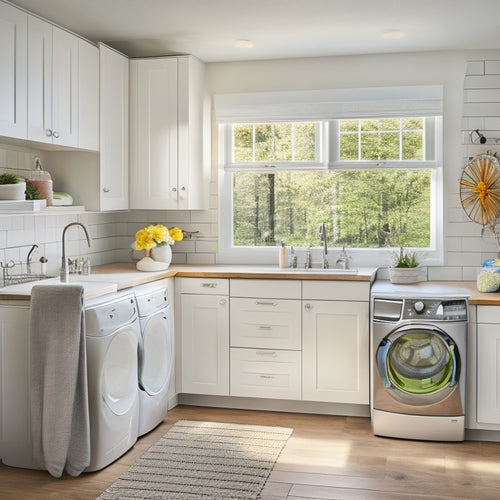
Transformative Techniques and Innovations in Mud Building
Share
You're about to discover the cutting-edge of mud building, where ancient techniques meet modern innovations. Revolutionary approaches to dome construction, earthbag building, and cob building are pushing the boundaries of sustainability and design flexibility. You'll learn how to overcome waterproofing challenges, incorporate natural insulation, and explore eco-friendly roofing materials. With techniques like human-powered lifting and artistic expression through skylights and curved walls, you'll reveal unique design possibilities. As you explore these transformative methods, you'll uncover the secrets to building structures that not only stand out but also support the planet - and there's still more to uncover.
Key Takeaways
• Earthbag building techniques offer artistic expression and design flexibility, allowing for unique features like skylights and curved walls.
• Cob mixture can be sculpted and shaped for bespoke designs, with considerations for wall plates and ridge beams in roof construction.
• Mud building enables unparalleled design flexibility, accommodating organic and curvaceous forms that reduce carbon footprint.
• Sustainable construction methods in mud building involve sourcing earthy materials locally and using eco-friendly tiles for a watertight seal.
• Innovative roofing techniques, such as using wooden boards or chipboard, provide insulation and protection for cob buildings.
Dome Construction and Considerations
Domes have been a staple in human construction for centuries, with their popularity resurging during the space-age architectural trend, largely popularized by Buckminster Fuller's geodesic domes.
As you consider building a dome, you'll need to address waterproofing challenges head-on. Guarantee your design allows for adequate waterproofing measures to prevent seepage and structural damage.
You'll also need to think about airflow considerations, as domes can be prone to stagnation. Proper ventilation is key to maintaining a healthy indoor environment.
Earthbag Building Techniques
You can tap into artistic expression and design flexibility in earthbag construction by incorporating unique features like skylights and curved walls into your project.
Foundation construction involves laying gravel-filled bags for stem walls, using environmentally friendly methods. For the dome structure, continuous bags filled with stabilized earth and reinforced upper dome rings provide stability.
You can also create unique keyhole doorways using recycled materials like old tires, adding a touch of sustainability and cost-effectiveness. With earthbag building techniques, you can let your creativity shine while building an eco-friendly and durable structure.
From Superadobe pool construction to art retreat structures, the possibilities are endless. Get ready to explore your artistic expression and design flexibility with earthbag building!
Cob Building and Roof Construction
Mixing clay, soil, straw, and sand creates a workable cob mixture for building walls that can be sculpted and shaped to fit your unique design vision. You can create curved lines, organic shapes, and even add decorative features like sculptures or mosaics. For roof construction, you'll need to take into account wall plates, ridge beams, and human-powered lifting for stability.
| Roof Construction Elements | Considerations |
|---|---|
| Wall Plates | Guarantee proper support for roof weight |
| Ridge Beams | Install for stability and structural integrity |
| Human-Powered Lifting | Utilize pulleys or levers for efficient lifting |
When it comes to living roof construction, you'll need to think about root barriers, drainage considerations, and tidying up edges for a finished look. With the right sculpting techniques and attention to detail, your cob building can become a stunning, eco-friendly masterpiece.
Roofing Materials and Techniques
With your cob building's walls and roof structure in place, it's time to explore the roofing materials and techniques that will protect your natural home from the elements.
You'll need a solid foundation, literally, with roofing boards that provide insulation and a surface for tile installation. Consider sustainable options like wooden boards or chipboard for a cost-effective and eco-friendly choice.
When it comes to tiles, opt for eco-friendly tiles that not only look great but also reduce your carbon footprint. For a more traditional look, use second-hand tiles, which balance aesthetics with practicality and sustainability.
Remember to secure those tejas curvas with limecrete, tile glue, or special clips, and don't forget proper installation techniques for a watertight seal.
Mud Building Design Flexibility
Designing a mud building allows for unparalleled flexibility, as its organic, curvaceous forms can be manipulated to accommodate unique features, such as built-in furniture or irregularly shaped windows. You can let your architectural creativity run wild, incorporating sustainable construction methods that blend seamlessly with the natural environment.
Want a circular doorway or an asymmetrical façade? No problem! Mud buildings can be shaped to fit your wildest design dreams. Plus, the earthy materials used in construction can be sourced locally, reducing carbon footprint and supporting the local community.
With mud building, the possibilities are endless, and the only limit is your imagination. So, get creative and build a structure that not only stands out but also stands up for the planet!
Natural Insulation and Waterproofing
You'll need to prioritize natural insulation and waterproofing techniques to guarantee your mud building remains cozy, dry, and durable, regardless of the climate or region you're building in. By incorporating eco-friendly solutions, you can secure your structure stays protected from the elements while minimizing its environmental footprint.
Sustainable practices like using natural materials, such as recycled materials or earthbags, can provide excellent insulation while reducing waste. Additionally, consider waterproofing methods that don't compromise the environment, like lime-based coatings or natural waxes.
Resource Guides for Mud Builders
Access an extensive library of building guides and resources, specifically tailored for mud builders, to streamline your construction process and guarantee a successful project.
You'll find thorough PDF guides covering earthbag construction, cob building, and roofing techniques. Stay updated with new guides released every six months, ensuring you're always in the know.
From natural insulation materials to waterproofing methods, these resources cover it all. Learn about building materials that prioritize sustainability practices, like recycled materials and environmentally friendly methods.
With lifetime access to updates, you'll be able to tackle any mud building project with confidence. Whether you're a seasoned pro or just starting out, these resource guides will be your go-to companion for achieving your mud building dreams.
Frequently Asked Questions
What Are the Benefits of Using Recycled Materials in Mud Building Projects?
As you start on your mud building adventure, you'll find that incorporating recycled materials is a golden ticket to sustainable living, offering eco-friendliness, cost-effectiveness, and a dash of creative flair to your project's overall aesthetic.
Can Mud Buildings Be Constructed in Areas Prone to Earthquakes and Natural Disasters?
You're wondering if mud buildings can withstand earthquakes and natural disasters? Absolutely! By incorporating seismic design principles and disaster resilience strategies, like reinforced earthbag construction and impact-resistant materials, you can build a mud home that's ready for whatever Mother Nature throws its way.
How Do I Ensure Pest Control and Termite Resistance in Mud Structures?
You'll want to outsmart those pesky pests by incorporating natural barriers, like termite-resistant earthbags and integrated systems that promote airflow, reducing moisture buildup, and making your mud structure a termite-free haven.
Are There Any Specific Zoning Laws or Regulations for Mud Buildings?
You'll need to navigate code enforcement and permitting processes for your mud building, so research local regulations and obtain necessary permits to avoid costly rework or even demolition - it's a wild ride, but worth it!
Can I Build a Mud Structure Without Prior Construction or Building Experience?
You can build a mud structure without prior experience, but don't go it alone! Find a mud mentor to guide you, and DIY confidence will follow - just remember, practice makes perfect (and a sturdy mud home)!
Related Posts
-

Revamp Your Laundry Room With Smart Space-Saving
You're tired of feeling cramped and disorganized in your laundry room, and it's time to revamp the space to make the ...
-

Create Your Own Kitchen Countertop Organizer System
To create your own kitchen countertop organizer system, start by evaluating your available counter space, identifying...

